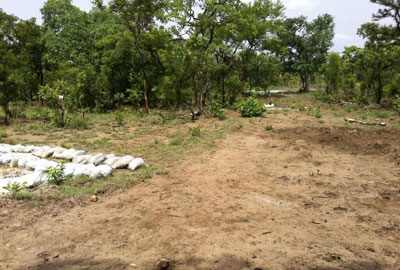Kandia Prospect

The Kandia prospect was discovered in 2010 during a program of reconnaissance field mapping. During this program a large area of previously unknown artisanal gold workings was discovered that comprise three main groups developed over approximately 600m of strike.
These workings occur within altered Birimian age metasediments and schists, that on a regional scale sit on a major granite/sediment contact that can be traced within Castle’s licences for at least 25km.
A sampling and mapping program was completed along the regional trend of the mineralisation. This work represented the first known systematic gold exploration conducted in this area and identified nine gold anomalies overs 12km of strike.
An initial 15,000m of RC drilling was undertaken to test these anomalies with significant results being returned from an area 3.5km south of the artisanal workings discovered in 2010.
Significant results from this drilling included;
- 11KARC143 40m @ 1.17 g/t gold from 20m
- inc. 25m @ 1.52 g/t gold from 30m
- 11KARC144 25m @ 0.70 g/t gold from 0m
- inc. 10m @ 1.25 g/t gold from 5m
- 11KARC204 15m @ 2.39 g/t gold from surface
- 11KARC210 25m @ 0.87 g/t gold from surface
- inc. 20m @ 1.05 g/t gold from surface
- 11KARC211 21m @ 1.15 g/t gold from 45m
- 11KARC221 40m @ 0.63 g/t gold from 25m
- inc. 20m @ 1.01 g/t gold from 30m
- 11KARC222 25m @ 0.48 g/t gold from surface
- 11KARC237 25m @ 1.23 g/t gold from 65m
- inc. 15m @ 1.78 g/t gold from 65m
- 11KARC247 20m @ 1.63 g/t gold from 35m
- 11KARC205 25m @ 0.76 g/t gold from 10m
Gold mineralisation at Kandia is hosted within silicified and weakly pyritic sediments (shales and siltstones) and generally forms a regular west dipping zone within a broader sediment package bounded to the east by granite. Aeromagnetic data shows this area as a magnetic low that is interpreted to represent magnetite destruction associated with a widespread alteration halo associated with the mineralising event.
Following extensive RC drilling during 2011 a maiden Mineral Resource Estimate for the Kandia gold prospect was announced totalling 3.3Mt @ 1.0g/t gold for 107,500 ounces.
Since the first resource drilling in 2011 Castle has completed extensive soil sampling, airborne geophysical surveys and drilled 264 RC holes for 19,541m.
The Resource estimate for Kandia was completed for two mineralised zones named the “4000 Zone”and “8000 Zone” that are situated along a regionally mineralised granite/sediment contact termed the Kandia Trend that can be traced for over 20km.
The definition of a shallow gold resource at Kandia was achieved less than 10 months from the first RC drilling commenced and clearly demonstrates that outcropping gold deposits are still capable of being discovered in Ghana.






